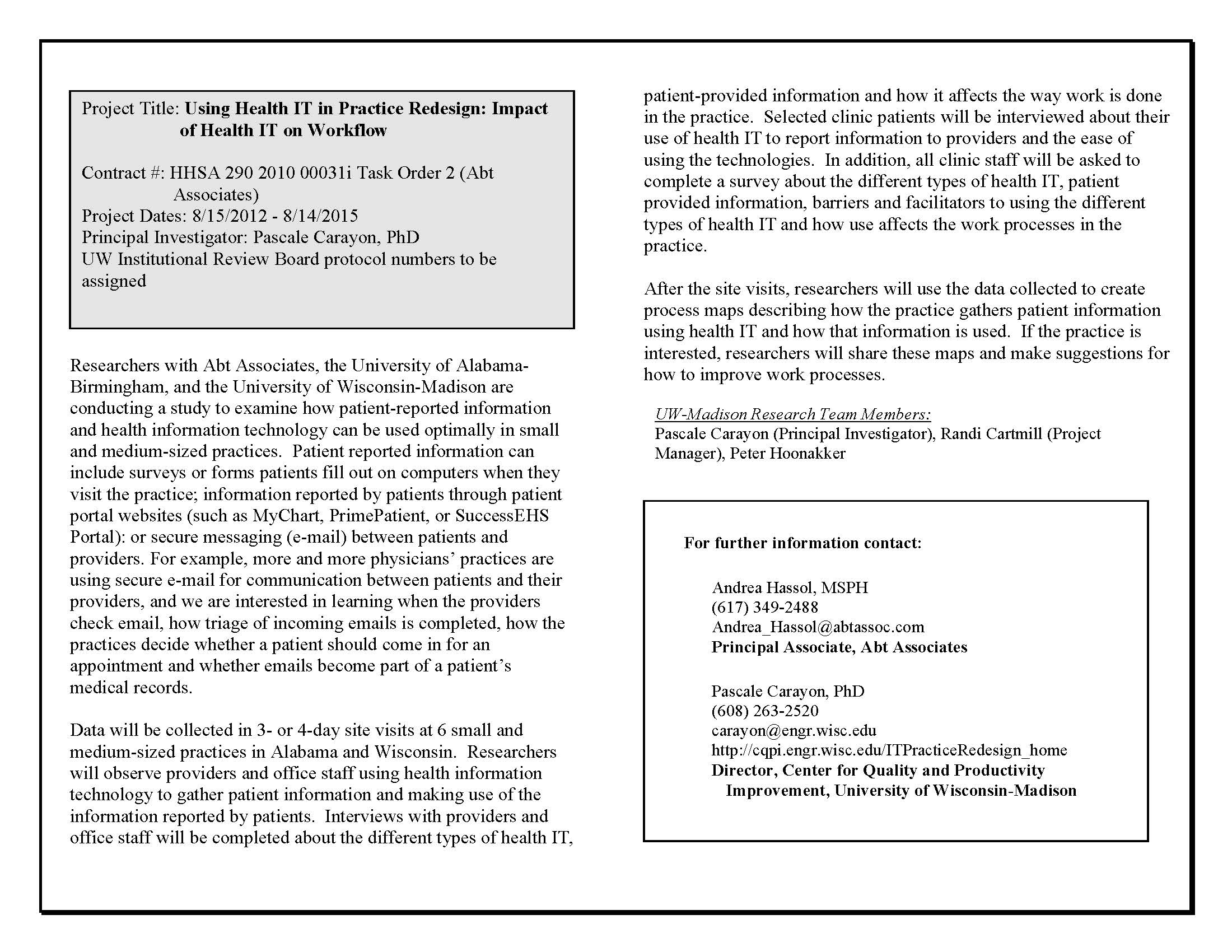Form #1 Form #1 Preliminary Conference Call Discussion Guide
Patient-Reported Health Information Technology and Workflow
Attachment A -- Preliminary Conference Call Discussion Guide
Preliminary Conference Call
OMB: 0935-0212
ATTACHMENT A
Preliminary Conference Call Discussion Guide
Hello, my name is ______________. As you may recall, I am calling from the University of Wisconsin-Madison. Thank you for agreeing to speak with us today.
On the phone is my colleague _____________, also from the University of Wisconsin-Madison.
We scheduled up to one hour for this call. Does this time still work with your schedule?
Thank you for the time to discuss this study. We are here to answer any questions or concerns you may have about your practice’s participation in the study and our visit to your practice.
Review the following topics:
Goal of the study
The goal of this project understand the influence of things such as patient or provider characteristics; physical environment and layout; technical training and support; functionality and usability of health IT; worker roles; staff workload, stress, and job satisfaction; and communication flows —in capturing and using patient-reported information in ambulatory health IT systems and associated workflows.
Definition and examples of patient-reported information
Patient-reported information can include symptoms (e.g., pain, fatigue), results of self-testing (e.g., blood glucose levels, blood pressure), weight questions and concerns, or over-the-counter medication use. Patients may be able to share information with the practice using
Patient portals (sometimes referred to as [electronic] personal health records or PHRs; allow patients to view portions of their medical records [e.g., laboratory test results] and support other health-related tasks such as making appointments or requesting medication refills. Some patient portal applications exist as stand-alone Web sites; other portal applications are integrated into an existing electronic health record [EHR] system);
Secure messaging with patients (use of secure e-mail between patients and clinicians, typically using the secure messaging functionality in the EHR and/or patient portal); and
e-forms (surveys that are administered using computerized media [e.g., tablets, laptops] to collect information from patients using pre-formatted forms before or during patient visits).
For example, more and more physicians’ practices are using secure messaging for communication between patients and their providers.
Site visit schedule, including involvement of clinicians, office staff, and patients
Data will be collected during the site visit to take place from XX/XX to XX/XX. Researchers will be collecting data from clinicians and staff through observations and interviews. Clinicians and staff will also be asked to fill out a short survey. Finally, a few patients in your practice will be asked what they think about providing information using health information technology applications.
Types of questions to be asked of clinicians, office staff, and patients
The clinician and office staff interviews will include discussion about the workflow observed during observations of clinician and office staff, facilitators and barriers to capturing and using patient-reported information, and whether there are uncommon workflow patterns that arise occasionally but were not observed.
The clinician and office staff survey will be used to collect data regarding attitudes about and perceptions of the health IT workflows staff engage in related to patient-reported information, and the barriers and facilitators associated with capturing and using patient-reported information.
Patients will be interviewed to understand the workflow of entering or reporting information from the patient’s perspective, the training required to do so, the time it takes to report information, and whether there are challenges, barriers, facilitators or workarounds commonly used by patients as they report information requested by their care providers.
Follow-up regarding Workflow Process Map(s)
Approximately one month after the site visit, you will be provided with a summary of your current workflow in the form of a process map(s). We will ask you to review the process map(s) and discuss it with us during a one hour phone call.
Finally, after we finish our data analysis, your practice will also be provided with the results of the study for your clinic in particular, and the overall study findings.
Do you have any questions about the study and what it will entail?
If yes, answer questions.
If not or once all questions are answered, thank you for your time and your participation.
I will send [name of Practice Manager] the Pre-Visit Questionnaire via email at [confirm email address] by [DATE]. We kindly ask you to complete it by [DATE].
Could you share the project summary with your staff and talk to them about the project?
We will see you on XX/XX for the site visit. If any questions come up in the meantime, feel free to contact me at [phone] or via email at [email address]

| File Type | application/vnd.openxmlformats-officedocument.wordprocessingml.document |
| Author | Laura Goodman |
| File Modified | 0000-00-00 |
| File Created | 2021-01-29 |
© 2026 OMB.report | Privacy Policy